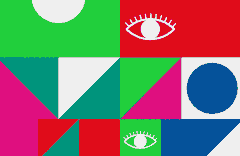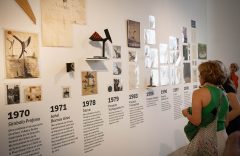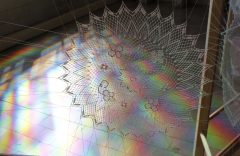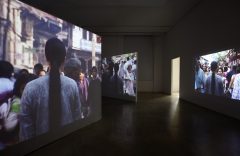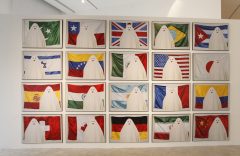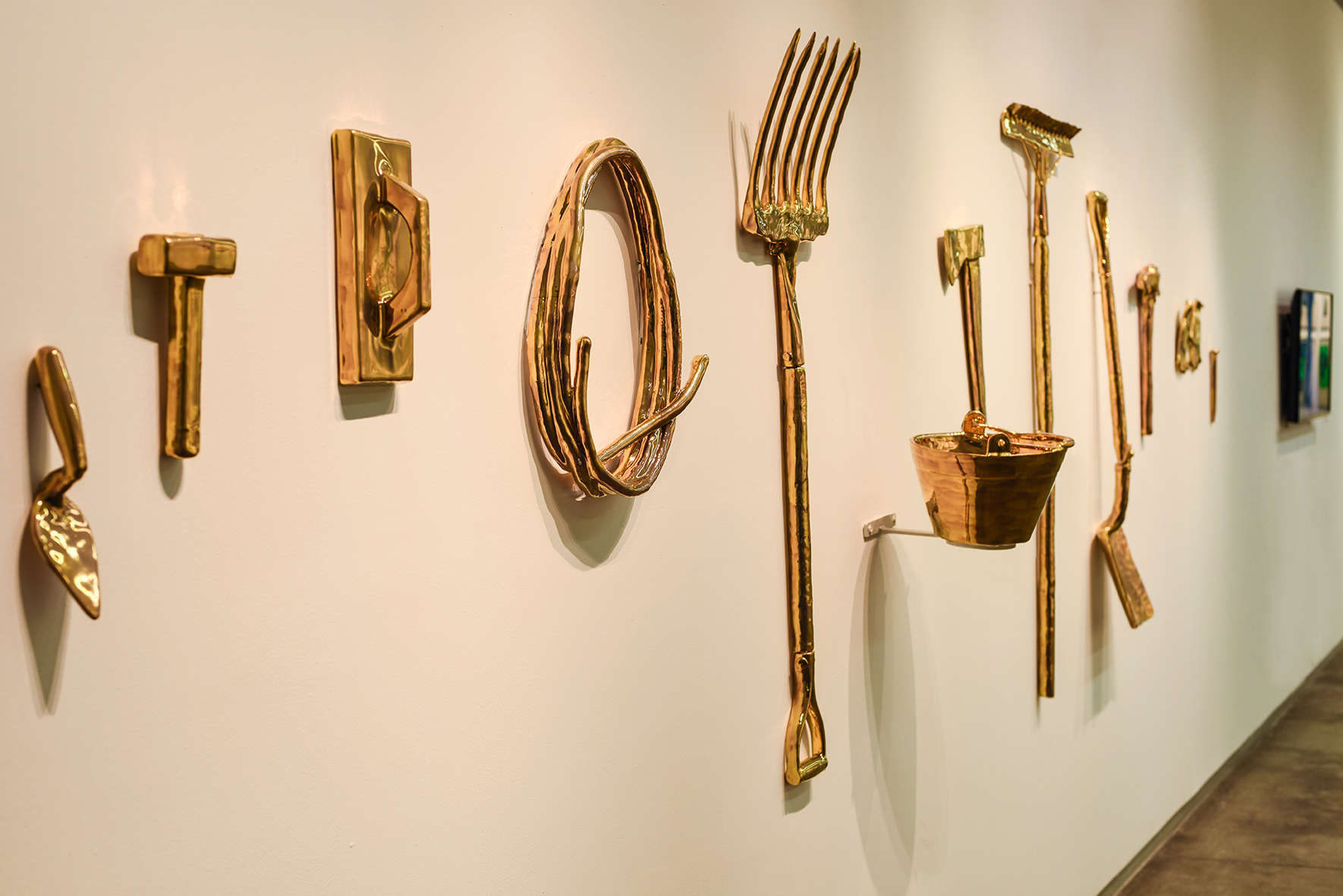
"La pampa se ve desde adentro", de Gabriel Baggio (2015). Cerámica esmaltada y lustre de oro. Colección José Luis Álvarez. Foto de Nicolás Levin.
BIENALSUR INAUGURATIONS IN AUGUST
In the month of August, the International Biennial of Contemporary Art of the South (BIENALSUR) continues its cycle of openings around the world and adds new countries, spaces and artists.
The new exhibitions will take place in the cities of Crans-Montana and Lens, in Switzerland; in Curitiba and in the state of Rio Grande do Sul in Brazil; in Las Palmas de Gran Canaria in Spain; and in the cities of San Juan and the City of Buenos Aires in Argentina.
Confronting other strategies of supremacy, unmasking the idea of cultural hegemony, becoming multiple, delocalizing, de-locating, BIENALSUR is capable of affirming the coexistence of different “ways of speaking”.
On August 4, the Parcours Culturel BIENALSUR Crans-Montana 2021 opens in Switzerland with a disturbing and unexpected exhibition that takes over the public space, curated by Diana Wechsler, the Artistic Director of BIENALSUR. The tension between nature and culture, between nature and society, is seen from the perspective of prominent artists, among whom are Iván Argote, Pablo Reinoso, Marie Orensanz, Denis Savary, Katja Schenker, Christian de Belair and Agustina Woodgate; and it includes a work and a tribute to French Christian Boltanski, recently deceased. The works, which will remain in place until March 2022, use different environmentally friendly materials, a concern that characterizes the Parcours Culturel BIENALSUR Crans-Montana 2021.
A giant needle that crosses the Oscar Niemeyer Museum in Curitiba, Brazil, is the work that Brazilian artist Geraldo Zamproni will present at BIENALSUR 2021 from August 5. The installation’s title is Vital Plots. Both in the use of materials and space, Geraldo’s works aim to visually alter the space that surrounds them, exploring the relationship between object, environment and observer. This intertwining produces an effect of estrangement and instability, a dialogue with the viewer that sustains itself through the references inscribed in the work: everyday elements displaced from their scale, use and habitat. Moving these elements to an unprecedented environment creates a new, exciting and very particular architecture.
The Fondation Opale returns to BIENALSUR cartography at Km 11920, in the city of Lens, in Switzerland, with Breath of life / Balambala, one of the most interesting exhibitions of the International Biennial of the South, framed in the curatorial axis Ways of Living/Ecological awareness, which brings together traditional art forms and cutting-edge digital technologies. Developed by Australia’s Mulka Project, a collective of Yirrkala artists whose mission is to preserve and protect the Yolŋu cultural heritage in northeastern Arnhem Land, under the leadership of community elders, the exhibition will be open from August 2021 until March 2022.
On August 20, at the Franklin Rawson Provincial Museum of Fine Arts in San Juan, Argentina, the exhibition Give and Give inaugurates with works by artists Aneta Bartos (POL/USA), Michael Dean (GBR), Leandro Katz (ARG), On Kawara (JPN), Nástio Mosquito (AGO), Oscar Murillo (COL), Otobong Ntanga (NGA), Yutaka Sone (JPN) and Gert Robijns (BEL) and Rirkrit Tiravanija (ARG/THA).
Curated by Charlotte Crevits (BEL) and Tommy Simoens (BEL) within the curatorial Axis Politics of Art, “Contrary to the popular expression of ‘giving and receiving’, the exhibition proposes, from the perspective of art, an alternative economy to that of the traditional model so ingrained in our post-Fordist society. In a world fundamentally guided by social, emotional and financial profit, “givers” appear as a strange species that contributes and collaborates with others without expecting anything in return. Thus, the ‘give and give’ dynamic enables sustainable and lasting affective relationships instead of short-term gains. Inspired by the possibilities of generosity in today’s society, the exhibition aims to challenge the rigidity of the prevailing neoliberal order by fostering both dynamic flows and other frameworks from which to connect by implementing tangible gestures. Several of the works that make up the show are the result of the commitments that the artists maintain outside the art world. Collectively, the artists who are part of Give and Give geographically connect divergent economies and raise questions about their social, industrial and emotional heritage within the framework of our global society”.
On August 21, also in San Juan, the exhibition Victor Grippo. An oven for two tables, curated by Carlos Godoy at the Casa Natal Sarmiento Museum and Library, will inaugurate. It presents three works by Argentine conceptual artist Víctor Grippo (1936-2002) that propose to reflect on food in times of crisis, the role of humanity vis-à-vis nature, that of citizens vis-à-vis the community and that of producers of meaning in front of an audience overwhelmed by urgency. Thus, Naturalizing man, humanizing nature (1977) presents food as a matter in transformation, science as a mediator of harmful practices for the ecosystem and food and work as assertive gestures in chaos; The artist’s food (1991) refers to the complex relationship between art and money, art and productivity, art and time; and the performance Construction of a popular oven to make bread (1972) evokes the community ritual of food. In this way, An oven for two tables tries to reflect on food in times of crisis and the multiple edges that emerge from this reflection on our role as human beings in the face of nature.
Coincidentally, in San Juan, the artist Rirkirt Tiravanija, who participates in Give and Give, retakes the performance “Construction of a popular oven to make bread” by Argentine artist Víctor Grippo (1936-2002) carried out in collaboration with Jorge Gamarra and Mr. Rossi in the Roberto Arlt Square in the city of Buenos Aires in 1972 and, as a tribute, will install five rural ovens in different public spaces of the city. Tiravanija’s action proposes to return Grippo’s work to its original context multiplied by five. The ovens will be lit and used by San Juan bakers who will distribute the bread to neighbors and passersby.
From August 23 to 27, the exhibition FACTORS 8.0 – In situ and online digital propagation will take place at the Federal University of Santa María in Brazil. The tension between these different spaces generates new dimensions and challenges that artists have gone through for months proposing, in many cases, dialogues and ruptures, frictions and expansions, in the virtual environment as well. The exhibition goes over these paths in which the space in situ absorbs and causes new reverberations in the online space. The pandemic -and all its experiences, consequences and damages- still moves and shocks society as a whole. In this context, the artists paved the way for emergency exits that would allow them to think and reflect, activate and create, even stressing their own artistic languages. The broken, reconfigured and vulnerable spatiality acquires other political, aesthetic and environmental dimensions; the different realities and temporalities manifested in situ and online meet, dispute and configure other horizons.
Artists: Lucas Bambozzi (BRA), Giselle Beiguelman (BRA) and Ilê Sartuzi (BRA), Carol Berger (BRA), Ana Laura Cantera (ARG), Fabio FON (BRA), Ío – Laura Cattani (FRA) and Munir Klant (BRA), Juan Miceli (ARG), Nic Motta (ARG), Laura Palavecino (ARG), Rebeca Stumm (BRA) and Fernando Velázquez (URY). Curatorship: Nara Cristina Santos-UFSM (BRA) and Mariela Yeregui-UNTREF (ARG).
In the Autonomous City of Buenos Aires, Argentina, on August 24 at the National Museum of Decorative Art, Plebeian Fantasies begins, bringing together artists such as Gabriel Baggio (ARG), Emil Finnerud (NOR), Luciana Lamothe (ARG) and Mehryl Levisse (FRA) with BIENALSUR curatorship by Argentine Leandro Martínez Depietri and the curatorial axis Politics of Art.
Martínez Depietri points out in his curatorial words: “Why do we continue to look at Buenos Aires palaces with longing? The admiration of these architectures of opulence usually comes along with a feeling of decadence in the face of the present when imagining them as evidence of a glorious lost time. In this reverie that relives life in its living rooms and projects us into it, however, its conditions of possibility are forgotten: the abysmal inequality between regions of the country and between social classes. We then find ourselves at the National Museum of Decorative Art, addressing the potential of its future –from aristocratic residence to public museum– throughout a question: how to sustain an appreciation of this heritage that can open space to other desires and views based on the aesthetic enjoyment produced by the ornamental exuberance of its building and its collection? We test possibilities based on settings and installations of a specific site that irreverently dialogue with its historicity, thus enabling other meanings. They propose plebeian fantasies through construction, reconstruction and deconstruction operations that escape nostalgia over the belle epoque. They invert signs, values and spatial logics, propose other design orders, highlight contrasts and push existing stylistic inconsistencies to the point of pastiche and kitsch as strategies to critically review heritage, expanding enjoyment towards new horizons of collective imagination”.
August 28 will be the inauguration date of Another Order. Tearing down borders at the Francis Naranjo Foundation in Las Palmas de Gran Canaria, in Spain.
The questioning of this type of conceptual frontiers is the one that appears at the center of this curatorial project curated by Diana Wechsler that seeks –parting from the encounter with a selection of works by Latin American and European artists- to dismantle pre-assumptions constructed over the centuries by Western thought to shape the parameters that ordered the world: let’s think, for instance, about the delimitation of maps that install relative positions and distances that put the center-periphery relationships “in the public eye” which, in fact, are defined in the development of the capitalist world-system.
Among the artists: Louise Botkay (BRA), Claudia Coca (PER), Colectivo Declinación Magética (ESP), Carlos Colín (MEX), Nicolás Eduardo Cox Ascencio (CHL), Rebecca de Marchi (ITA), Rodrigo Etem (ARG), Maíra Flores (BRA), Gabriel Garcilazo (MEX), Alfredo Ledesma Quintana (PER), Gaby Messina (ARG) and Ana Paula Penchaszadeh (ARG), Ricardo Villa (BRA).
The review of the colonial parameters from the critical gaze of each of the artists that make up this exhibition seeks to invite the public to think about the possibility of “another order”, trying to make this exhibition a space for thought.
The August inaugurations will culminate on the 28th at MUNAR, in La Boca, also in the Autonomous City of Buenos Aires, with the exhibition of Argentine artist Alejandra Fenochio, curated by Charly Herrera. The show will be open until September 25, 2021.
The third edition of BIENALSUR, the art biennial born in Argentina, recognized this year as “the biennial of art’s resistance and resilience in a pandemic”, will take place from July to December 2021 in more than 23 countries and the Vatican, 50 cities, 124 venues, with the participation of about 400 artists.
News
